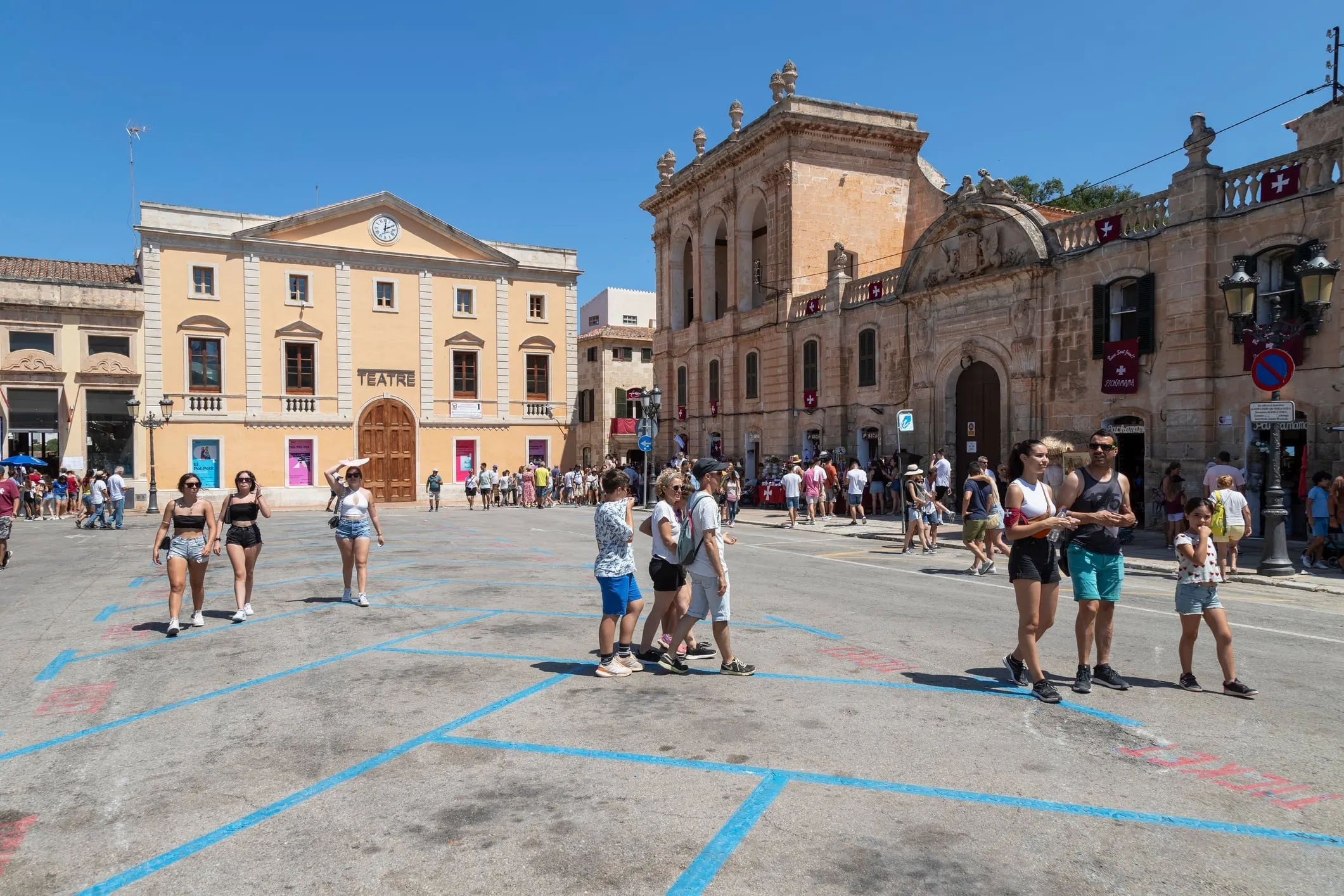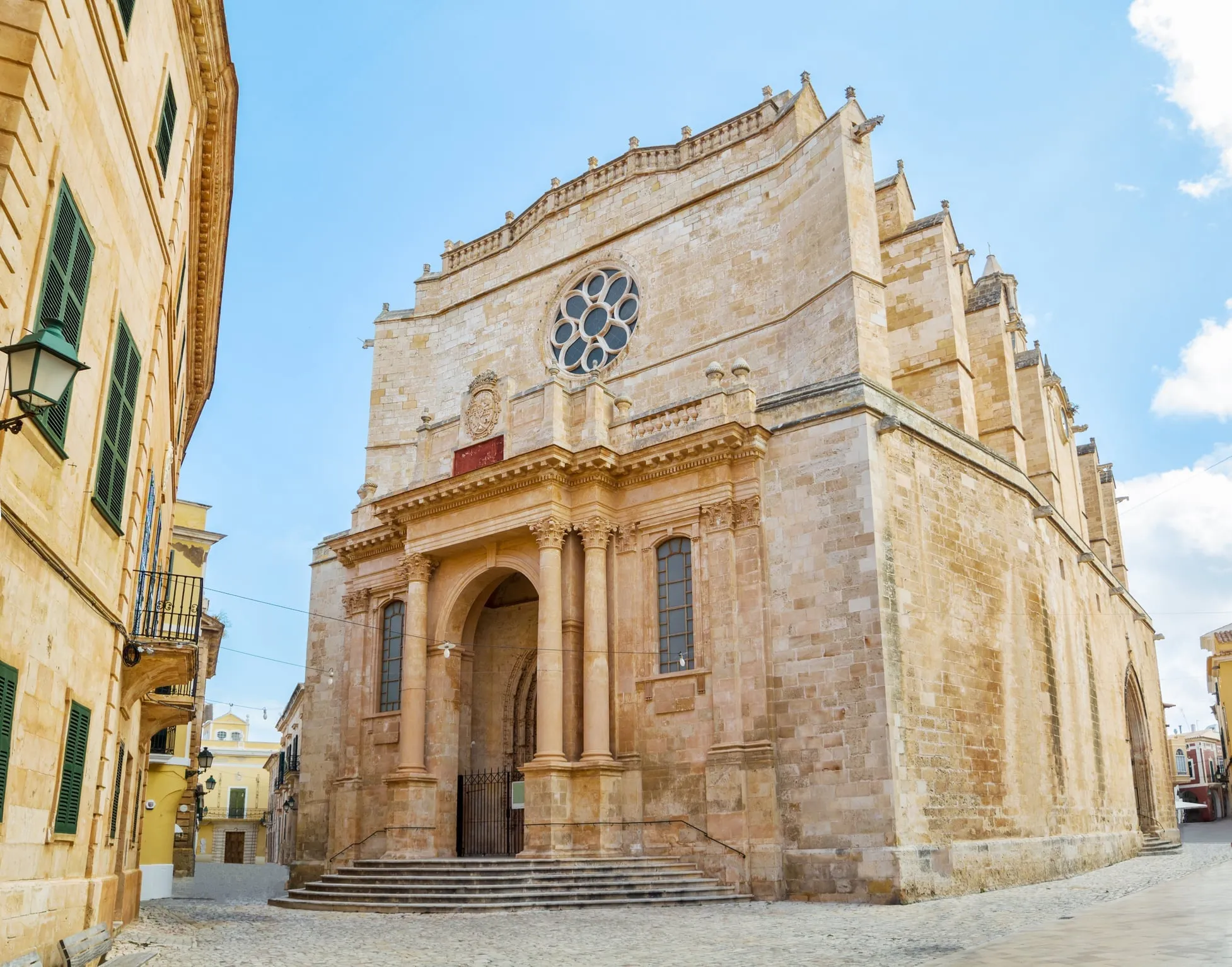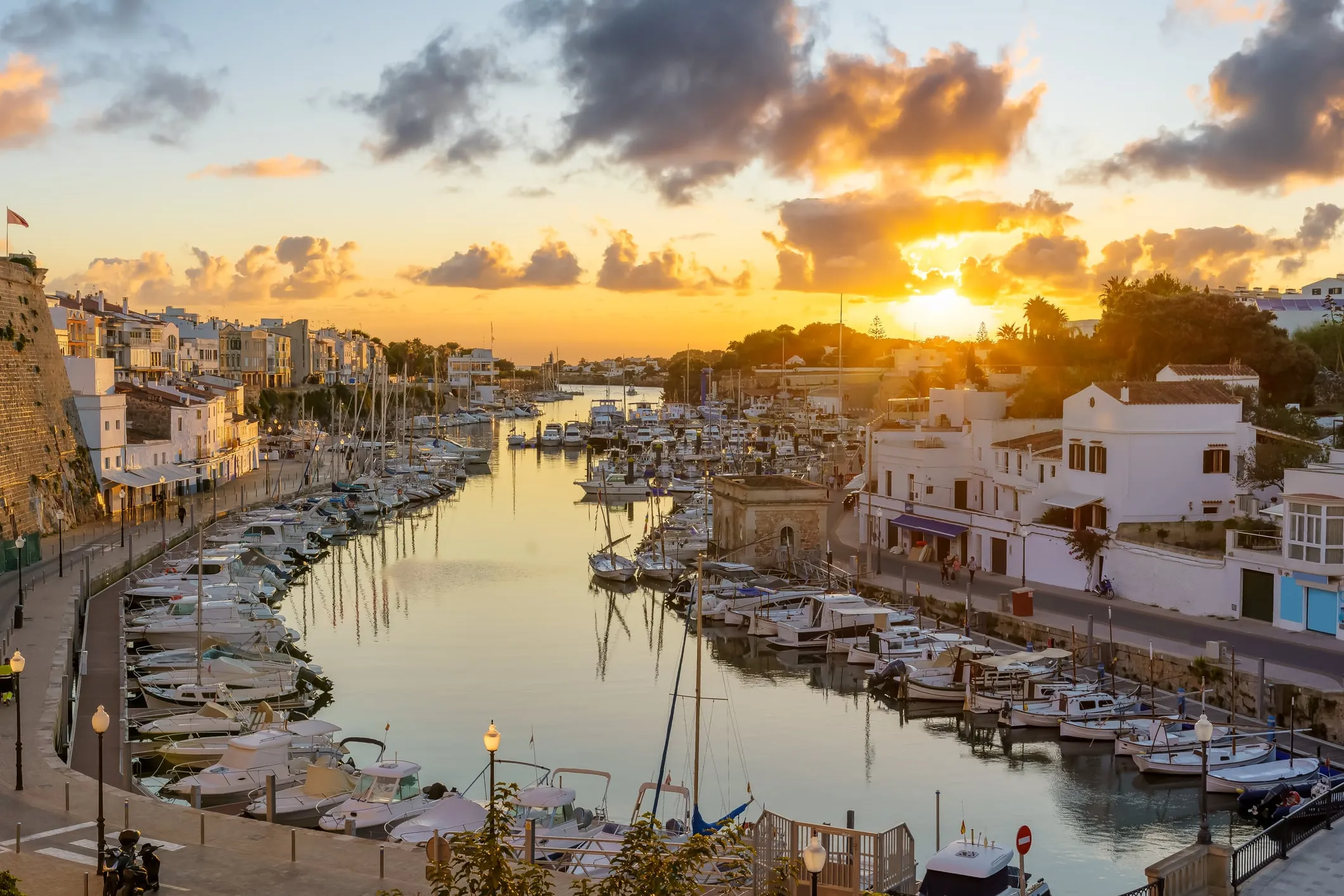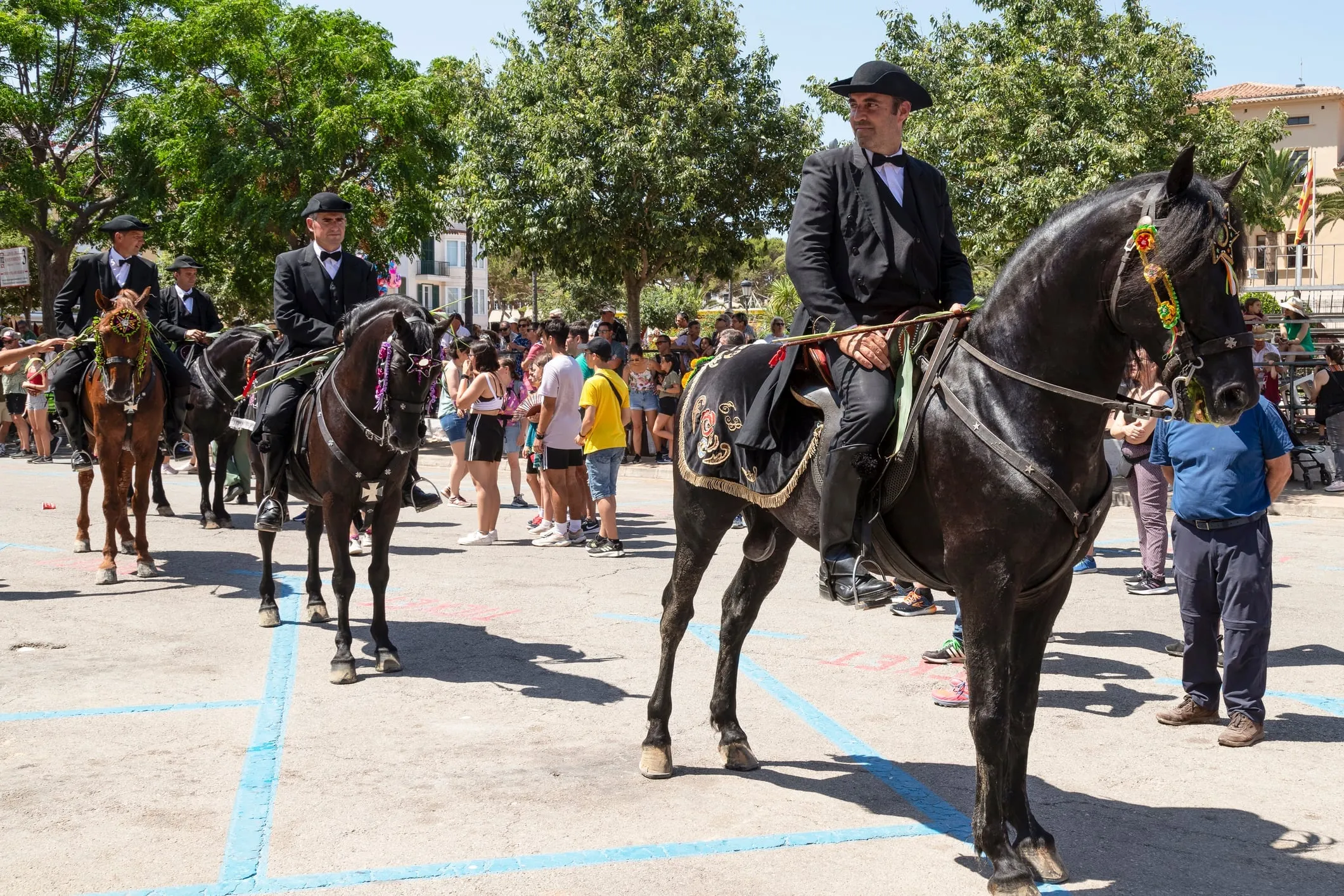At 5:47am on June 24th, a man in medieval dress rides a black horse through Ciutadella’s Plaça des Born while 10,000 people who haven’t slept throw hazelnuts at him. The horse rears on command, front hooves pawing air above the crowd, while brass bands play songs written when Menorca was British. This is Sant Joan, Ciutadella’s signature madness, but the limestone city performs smaller miracles daily: fishermen selling catch at the old port for €8 per kilo, locals swimming in turquoise calas accessible only by scrambling down cliff paths, restaurants where €3 tapas haven’t changed since 1960.
This former capital of Menorca – stripped of that title in 1722 after backing the wrong side in the War of Spanish Succession – wears its diminished status with aristocratic disdain. While Mahón got the British harbor and the government buildings, Ciutadella kept the cathedral, the palaces, and the attitude that real Menorcans live west of Alaior.
The Old City: A Limestone Maze
Plaça des Born: The Living Room
Every Ciutadella story starts in Plaça des Born, the rectangular plaza where Turkish pirates massacred 3,000 residents in 1558, where Franco gave speeches from the town hall balcony, where teenagers now practice skateboard tricks on marble steps worn smooth by five centuries of footsteps.
The obelisk in the center commemorates the Turkish raid – though locals will tell you it really marks where Ciutadella’s nobility made their last stand, preferring death to slavery in Algiers. The surrounding palaces, painted ochre and salmon pink, belong to families who trace their lineage to the Catalan conquest of 1287. Their shuttered windows hide ballrooms where Sant Joan committees plan next year’s chaos eleven months in advance.
Morning Ritual at Plaça des Born:
- 7am: Café Balear opens, espresso €1.40
- 8am: Street cleaners wash horse droppings from Sant Joan practice
- 9am: Tourist office opens (free maps worth grabbing)
- 10am: Palace tours begin (€5, Monday/Wednesday/Friday)
- 11am: Heat drives everyone to shaded arcades

Plaça des Born at 7pm: The obelisk marks where 3,000 died in 1558. The surrounding palaces belong to families who still meet monthly to plan Sant Joan, eleven months of preparation for 48 hours of chaos.
The Cathedral Quarter
Cathedral of Menorca
€4 entry • 10am-1pm, 4-7pm • Closed Sunday morning
Built on a mosque that was built on a Roman temple that was built on a Talayotic sanctuary, the cathedral is Menorca’s spiritual layer cake. The Gothic nave from 1362 struggles to contain a Baroque chapel added in 1789 where someone thought gold leaf improved everything. The bell tower offers views to Mallorca for €2 extra, though the 94 steps in 35°C heat test your devotion.
The real treasure is the cathedral museum’s collection of silver made from New World colonies – chalices, monstrances, and processional crosses that represent genocide transformed into liturgical objects. The museum guide, María, a historian who should be teaching at university, explains this contradiction if you ask in Spanish.
Secret Cathedral Access: The side door on Carrer del Roser stays open during siesta for silent prayer. Slip in at 3pm when the nave is empty, light filters through stained glass, and pigeons roost in roof beams.

The Cathedral of Menorca: Gothic bones from 1362 dressed in Baroque gold from 1789. The bell tower costs €2 extra but delivers views to Mallorca on clear days.
The Noble Palaces
Ciutadella’s aristocracy built 40 palaces between the 14th and 18th centuries, their facades competing for elaborate doorways while their interiors hid courtyards designed for privacy and ventilation. Three open for tours, though the real pleasure is peering through iron gates at gardens where palm trees shade marble fountains.
Palau Salort
€5 entry • Tours Monday/Wednesday/Friday 10am
The only palace maintaining its original furnishings, Salort feels like the family stepped out for coffee in 1850. The guided tour (Spanish/English) reveals a kitchen with 200 copper pots, a library where books include first editions of Cervantes, and a ballroom where mirrors multiply candlelight into infinity.
The garden contains Menorca’s largest rubber tree, planted in 1815 from a seed brought from Brazil. Its aerial roots have created a forest-within-a-tree covering 300 square meters.
Ses Voltes: The Whitewashed Arcades
The arcaded street of Ses Voltes (Joseph Maria Quadrado) creates Ciutadella’s most photogenic tunnel, its whitewashed arches framing shops selling everything from €3 espadrilles to €300 leather bags. Built after the 1558 Turkish raid to provide covered escape routes, the arcades now shelter the island’s most aggressive retail therapy.
Ses Voltes Shopping Intelligence:
- Ca’n Moll: Avarcas (traditional sandals) for €45, not the €20 Chinese copies
- Herboristeria: Herbal remedies where locals buy hangover cures
- Casa Gómez: Fabrics and buttons since 1889, owner speaks only Catalan
- Multiple Tourist Traps: Identified by “Sale” signs and made-in-China magnets
The Port: From Fish Market to Gin Terrace
The Working Harbor
The port of Ciutadella occupies a fjord-like inlet protected from winter storms by 20-meter cliffs. At the narrow entrance, barely 30 meters wide, you understand why medieval engineers could defend this harbor with one cannon and bad intentions.
The fish market at the port’s east end operates Tuesday-Saturday 7-9am, when boats return with prawns, monkfish, and red mullet. Prices start at €8 per kilo for sardines, reaching €45 for langosta. The fishermen, average age 55, complain about quotas, fuel prices, and their children studying tourism instead of learning nets.
Pla de Sant Joan
The harbor promenade
This waterfront walkway runs 800 meters from the fish market to the marina, passing restaurants where sunset dinners cost your mortgage payment. The smart money drinks at Bar Marítimo (€3 beers) then eats at the backstreet places where locals go after kitchen shifts.
Evening Progression:
- 6pm: Yacht crews prepare sundowners
- 7pm: First restaurant hawkers appear
- 8pm: Sunset crowd arrives for photos
- 9pm: Dinner service begins (too early for locals)
- 10:30pm: Locals appear for actual dinner
- Midnight: Gin-fueled arguments about football
Restaurant Reality Check
Tourist Traps (beautiful but overpriced):
- Es Tast de na Sílvia: €80 paella you’ll Instagram then regret
- Café Balear: Used to be good, now coasting on reputation
- Any place with photos of food on the menu
Local Approved:
- S’Amarador
Carrer de Sant Francesc, 12: No view but spectacular rice dishes €16-22 - Cas Ferrer de sa Font
Portal de sa Font, 6: Hidden courtyard, €25 menu worth €40 - Mon Restaurant
Pla de Sant Joan, 6: Yes, it’s on the port, but chef Joan doesn’t care about tourists. €35 tasting menu

The port at golden hour: Where €8/kg fish from morning boats becomes €80 dinners by sunset. The narrow inlet, barely 30 meters wide at the entrance, could be defended with one cannon and bad intentions.
The Beaches Within Walking Distance
Cala en Blanes
2km west • 30-minute walk or €8 taxi
The closest beach to Ciutadella is a small urbanization built for British package tourists in the 1970s. The beach itself – a narrow strip of sand between apartment blocks – won’t win beauty contests, but the shallow water stays warm through October and the beach bar serves decent bocadillos for €5.
Cala en Brut
2.5km west • 40-minute walk
Not a beach but a series of flat rocks with ladders into deep, clear water. Local teenagers colonize the jumping platforms (3, 5, and 8 meters) while their grandparents swim laps in the natural pools. No sand, no services, no tourists who can’t handle rocks.
Sa Platja Gran
1km south • 15-minute walk
Ciutadella’s “city beach” is a 200-meter curve of sand below the hotels. Overcrowded by 10am in summer, it serves its purpose for quick swims. The beach bars charge €8 for a coffee that costs €1.40 three streets inland.
Sant Joan: The Madness Method
Understanding the Festival
June 23-24 annually
Sant Joan isn’t a festival – it’s collective insanity with medieval protocols. For two days, horses become sacred, alcohol becomes water, and hazelnuts become projectiles. The tradition dates to the 14th century, though nobody agrees if it celebrates John the Baptist, the summer solstice, or just Menorca’s ability to party harder than Ibiza.
The Key Players:
- Caixers: Riders representing medieval guilds
- Cavalls: Menorcan horses trained to rear on command
- Fabioler: Man with lamb skin and staff who leads proceedings
- Everyone Else: Drunk, sleep-deprived, throwing hazelnuts
The Schedule That Matters
June 23:
- 2pm: First gin-pomada consumed
- 6pm: Flabioler’s first rounds
- 7pm: Horses parade through town
- 9pm: Everyone drunk
- Midnight: Bonfires and more gin
June 24:
- 8am: Horses charge through crowd at Plaça des Born
- 10am: Mass (horses attend)
- 12pm: More charging, rearing, near-death experiences
- 6pm: Final jaleo (horse games)
- 8pm: Collective hangover begins
Survival Guide
Do:
- Book accommodation by February (seriously)
- Wear closed shoes (horse hooves hurt)
- Join the pomada drinking (resistance is futile)
- Throw hazelnuts (gently)
- Touch the horses’ chests (supposedly lucky)
Don’t:
- Stand behind horses (they kick)
- Expect sleep (hotels blast music all night)
- Drive (roads close, police everywhere)
- Wear white (pomada stains)
- Expect anything to make sense

Sant Joan madness: A Menorcan horse performs the ‘bot’ (rear) in Plaça des Born while 10,000 people who haven’t slept for 36 hours throw hazelnuts and drink pomada. The tradition dates to the 14th century; the hangover feels older.
Practical Matters
Getting Here
From Mahón:
- Bus: €5.50, 45 minutes, hourly
- Taxi: €45-50, 35 minutes
- Rental car: €35/day plus parking hassle
From Palma de Mallorca:
- Fly to Mahón then bus: Total €50-250
- Ferry to Mahón then bus: Total €55-95
From Barcelona:
- Direct ferry May-October: €65-120, 4 hours
- Fly to Mahón then bus: Total €35-230
Where to Stay
Old Town
€70-180/night • Everything walkable
Hotel Born Carrer Sant Francesc, 8 – 17th-century palace, breakfast in courtyard, walls thick enough to muffle Sant Joan. €140/night.
Hostal Ciutadella Carrer Sant Eloi, 10 – Basic but central, owner Antonio provides hand-drawn maps to secret beaches. €75/night.
Near the Port
€90-250/night • Sunset views
Hotel Port Ciutadella Passeig Marítim, 36 – Waterfront location, rooftop pool, overpriced but convenient. €180/night.
Beach Suburbs
€60-150/night • Need transport
Apartments in Cala en Blanes or Cala Santandria. Cheaper but you’re in tourist ghetto eating fish and chips.
Getting Around
On Foot: Old town is 10 minutes across Bicycle: Rental €10/day, useful for beaches Bus: €2 to beaches, limited schedule Taxi: €8-15 anywhere around Ciutadella
Money Matters
Daily Costs:
- Bare minimum: €50 (hostel, self-catering, free beaches)
- Comfortable: €100 (hotel, restaurants, some activities)
- Splurge: €200+ (palace hotel, sunset dinners, boat trips)
Free Entertainment:
- Walking the old town’s 40 palace facades
- Sunset from Sa Farola (lighthouse walk)
- Morning fish market theater
- Cathedral exterior and plaza
- Swimming at Cala en Brut
Beyond Tourist Ciutadella
The Industrial Estate Reality
Behind the medieval romance, Ciutadella’s Polígono Industrial employs half the working population. This is where carpenter workshops make the green shutters for tourist villas, where Mahón cheese ages in warehouses, where mechanics keep 30-year-old Seats running because nobody can afford new cars.
The Pakistani restaurant hidden between auto repair shops serves curry for €6 to construction workers. The Romanian bar opens at 5am for crews heading to hotel renovations. This unglamorous Ciutadella pays for the pretty one tourists photograph.
The Naveta des Tudons
3km east • €2 entry
This Bronze Age burial chamber from 1000 BCE looks like an upturned boat made of stone. It held 100 bodies, their bones mixed together because Talayotic peoples believed in collective afterlife. The site gets 20 visitors daily despite being Menorca’s most important prehistoric monument.
Stand inside the chamber at noon when sunlight angles through the entrance. The temperature drops 10 degrees. The silence feels thick. You understand why Bronze Age peoples chose this spot for their dead, halfway between Ciutadella and the interior mountains, between settlement and wilderness.
The Cheese Route
Three farms near Ciutadella offer tours showing traditional Mahón cheese production:
Subaida Farm Camí de Sa Canova
- Tour: €8 including tasting
- Best time: 7am for hand-milking
- Buy: Fresh cheese €15/kg (half tourist shop price)
The farmer, Tomeu, explains in broken English how his grandfather’s grandfather started making cheese, how the cows eat wild herbs that flavor the milk, how EU regulations almost killed traditional methods until tourists started paying for authenticity.
Seasonal Intelligence
Summer (June-September)
Everything open, everywhere crowded. Beaches require 8am arrival. Restaurants need reservations. Sant Joan creates June madness. Heat reaches 35°C. Sea temperature perfect at 26°C.
Autumn (October-November)
Tourists vanish after October 15. Rain arrives but briefly. Restaurants reduce hours. Hotels drop prices 40%. Best swimming weather – warm sea, cool air.
Winter (December-March)
Half of Ciutadella closes. Storms lash the coast. Cathedral and palaces maintain hours. Perfect for hiking. Locals reclaim their bars. Rain creates temporary lakes in fields.
Spring (April-May)
Wildflowers explode across countryside. Easter brings mini-Sant Joan. Weather unpredictable – sun, rain, wind in same day. Restaurants reopen. Germans arrive for cycling.
The Deeper Truth
Ciutadella operates on two frequencies. The surface one serves tourism – restored palaces, waterfront restaurants, guided tours in four languages. But tune into the underlying frequency and you find a small city maintaining traditions not for tourists but for itself.
Watch the Sant Joan committees meeting in November to plan next June’s festival. See families visiting grandparents every Sunday for three-hour lunches. Notice how shopkeepers switch from Spanish to Catalan when locals enter. Observe fishermen mending nets while yacht crews pay €500 for moorings.
The city’s genius lies in monetizing its beauty without surrendering its soul. Those palace tours fund restoration. Restaurant prices subsidize fishing boats. Tourist taxes pay for street cleaning. Sant Joan brings millions in revenue that sustain Ciutadella through winter.
Come for Instagram sunsets and medieval streets. But stay for the morning when you’re the only foreigner at the fish market, when the cathedral bells count time as they have since 1362, when you realize Ciutadella’s limestone maze leads not to tourist attractions but to a living city that happens to be beautiful.
The secret isn’t choosing between authentic and touristic Ciutadella. It’s understanding they’re the same place at different hours, in different seasons, viewed from different angles. The city that charges tourists €80 for paella is the same one where locals eat €3 tapas. You just need to know when to switch frequencies.
